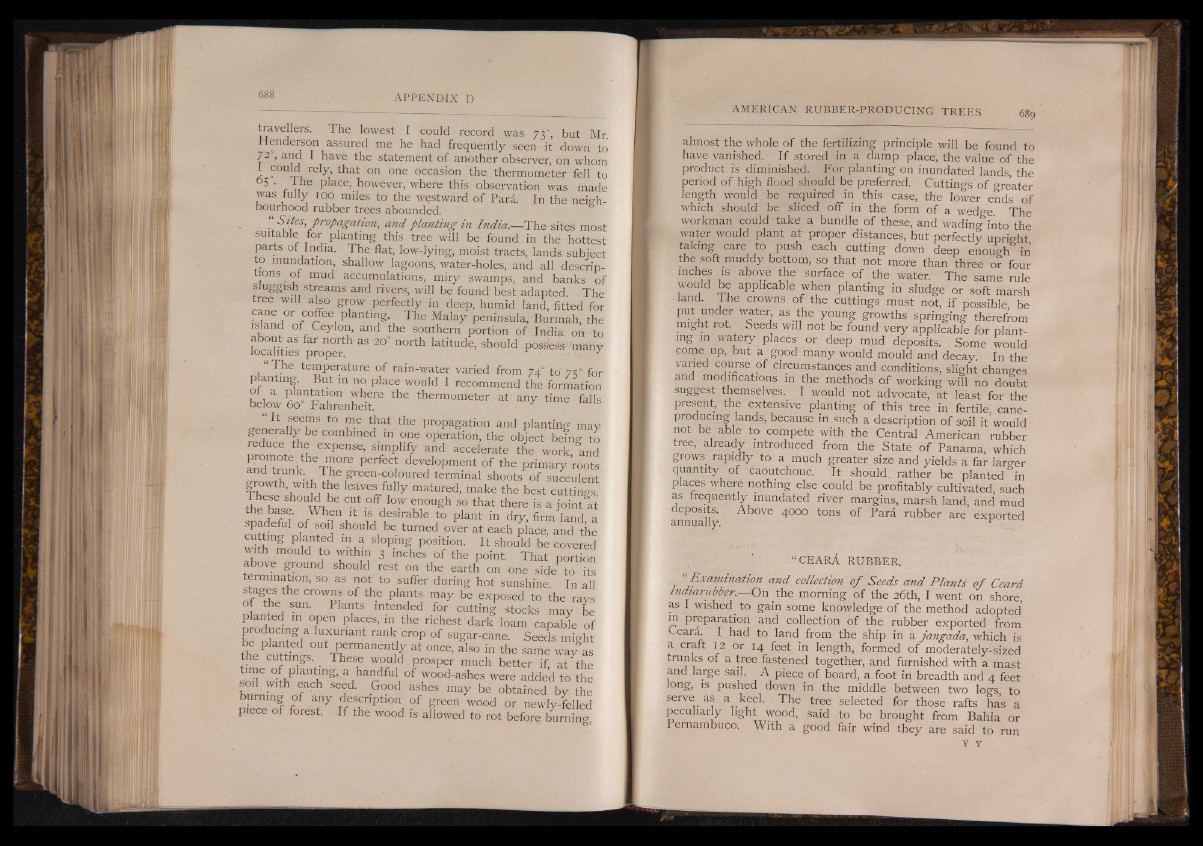
travellers. The lowest I could record was 73°; but Mr.
Henderson assured me he had frequently seen it down to
t 2°’ aim 1 have tbe statement ° f another observer, on whom
i . reIy> tbat on one occasion the thermometer fell to
05 . I he place, however, where this observation was made
was fully 100 miles to the westward of P a r i In the neighbourhood
rubber trees abounded.
“ 'Sites, propagation, and planting in India.— The sites most
suitable for planting this tree will be found in the hottest
parts of India. The flat, low-lying, moist tracts, lands subject
to inundation, shallow lagoons, water-holes, and all descriptions
of mud accumulations, miry swamps, and banks of
sluggish streams and rivers, will be found best adapted. The
tree will also grow perfectly in deep, humid land, fitted for
m m m 1 W 1 1 The ^ alay island of Ceylon, and the southern pPoerntiionns uolaf> BInudrmia ahon, thtoe
S t i S p i o p ° e f “ 20 n ° r lh ,a titU d e ' Sh0,,ld
“ The temperature o f rain-water varied from 74° to 7C for
planting. But in no place would I recommend the formation
a P n at!on where the thermometer at any time falls
below 60 Fahrenheit. ■
It seems to me that the propagation and planting may
generally be combined in one operation, the object beino- to
reduce the expense, simplify and accelerate the work and
and^runk Th°re S f S j dev,eloP™nt of the primary’roots
and trunk. The green-coloured terminal shoots of succulent
growth with the leaves fully matured, make the best cuttings
Ihese should be cut off low enough so that there is a joint at
the base. When it is desirable to plant in dry, firm land a
spadeful of soil should be turned over at each place, and the
cutting planted in a sloping position. It should be covered
with mould to within 3 inches of the point. That portion
above ground should rest on the earth on one side to its
termination, so as not to suffer during hot sunshine. In all
stages the crowns of the plants may be exposed to the rays
nL ^ PIai?ts “Fended for cutting stocks may be
planted in open places, in the richest dark loam capable of
producing a luxuriant rank crop of sugar-cane. Seeds might
fhl T out permanently at once, also in the same way as
the cuttings These would prosper much better if, at the
S I 6. ° 4 p t‘ng’ a haudful of wood-ashes were added to the
soil with each seed. Good ashes may be obtained by the
burning of any description of green wood or newly-felled
piece of forest. If the wood is allowed to rot before burning,
almost the whole of the fertilizing principle will be found to
have vanished. I f stored in a damp place, the value of the
product is diminished. For planting on inundated lands, the
period of high flood should be preferred. Cuttings of greater
length would be required in this case, the lower ends of
which should be sliced off in the form of a wedge The
workman could take a bundle of these, and wading into the
water would plant at proper distances, but perfectly upright
taking care to push each cutting down deep enough in
the soft muddy bottom, so that not more than three or four
inches is above the surface of the water. The same rule
aPPllcable when planting in sludge or soft marsh
land. The crowns of the cuttings must not, if possible be
put under water, as the young growths springing therefrom
might rot. Seeds will not be found very applicable for planting
in watery places or deep mud deposits. Some would
coiqe up, but a good many would mould and decay. In the
varied course of circumstances and conditions, slight changes
and modifications in the methods of working will no doubt
suggest themselves. I would not advocate, at least for the
present, the extensive planting of this tree in fertile cane-
producing lands, because in such a description of soil it’would
not be able to compete with the Central American rubber
tree, already introduced from the State of Panama, which
grows rapidly to a much greater size and yields a far larger
quantity of caoutchouc. It should, rather be planted in
places where nothing else could be profitably cultivated, such
as frequently inundated river margins, marsh land, and mud
amualf' 4° ° ° t0nS ° f Pard rubber are exported
“ CEARA RUBBER.
“ Examination and collection o f Seeds and Plants o f Ceara
Indiarubber.— On the morning of the 26th, I went on shore,
as I wished to gain some knowledge of the method adopted
in preparation and collection of the rubber exported from
Ceara. I had to land from the ship in a jangada, which is
a craft 12 or 14 feet in length, formed of moderately-sized
trunks of a tree fastened together, and furnished with a mast
and large sail. A piece of board, a foot in breadth and 4 feet
lonS> 1S pushed down in the middle between two logs to
serve as a keel. - The tree selected for those rafts has a
peculiarly light wood, said to be brought from Bahia or
Pernambuco. With a good fair wind they are said to run
V Y